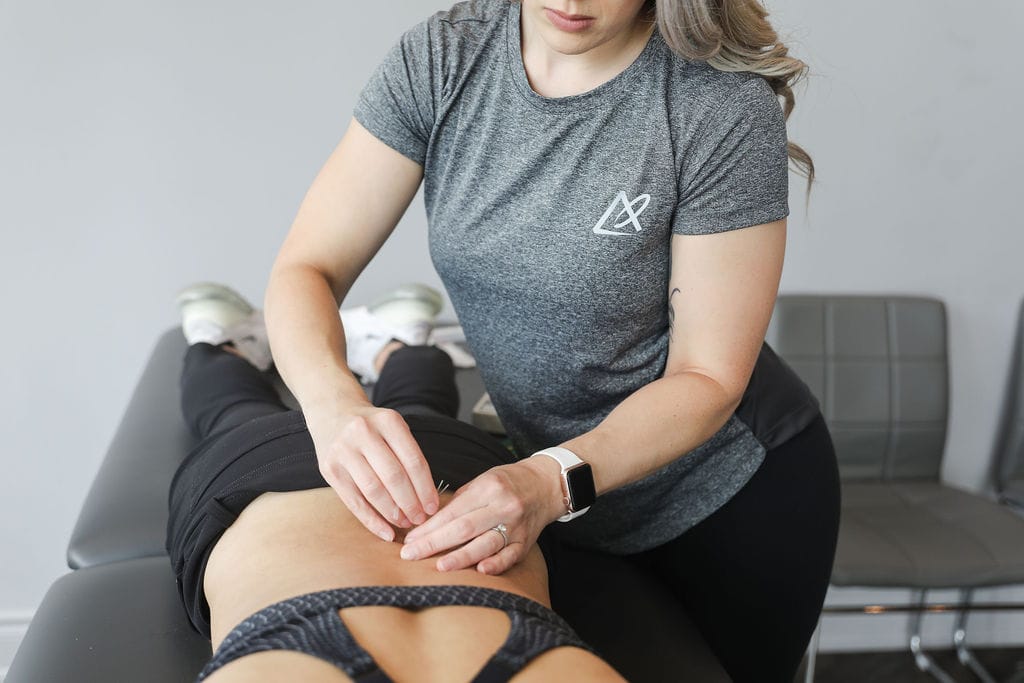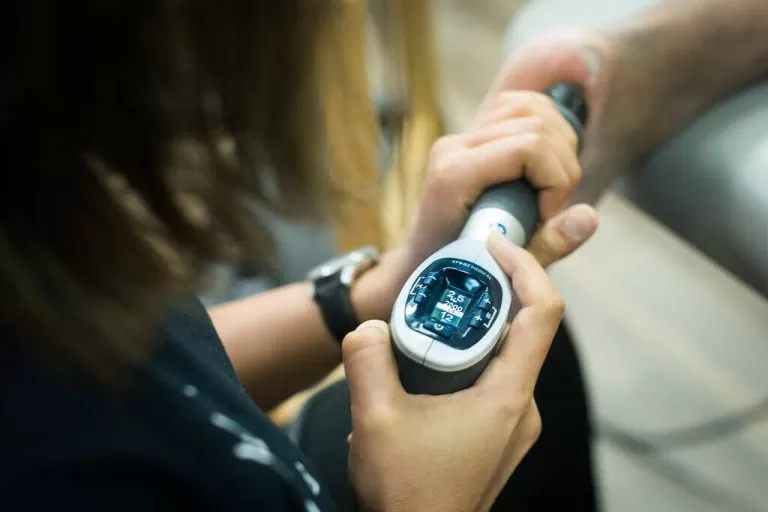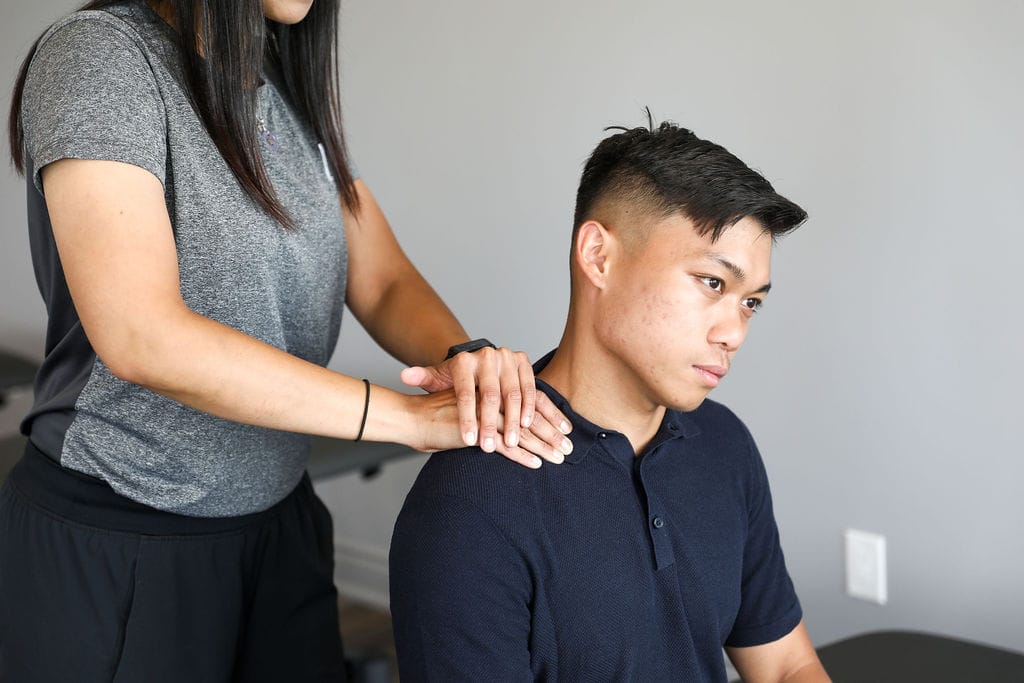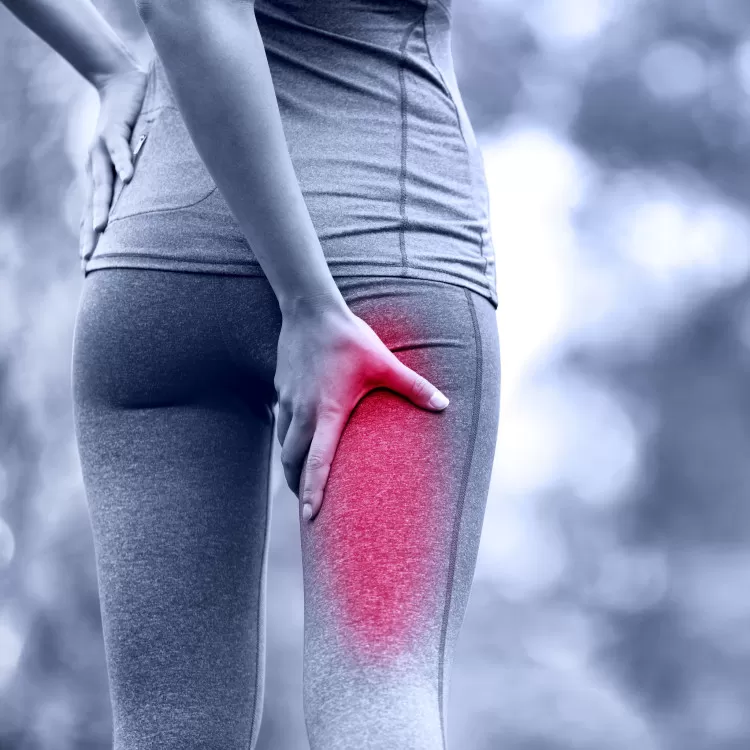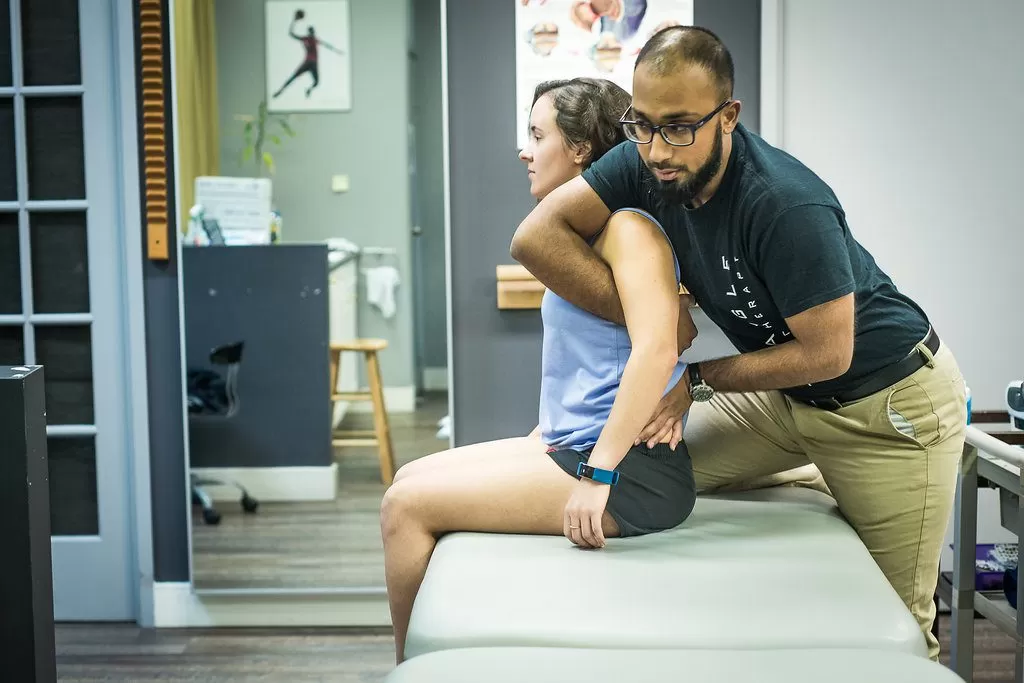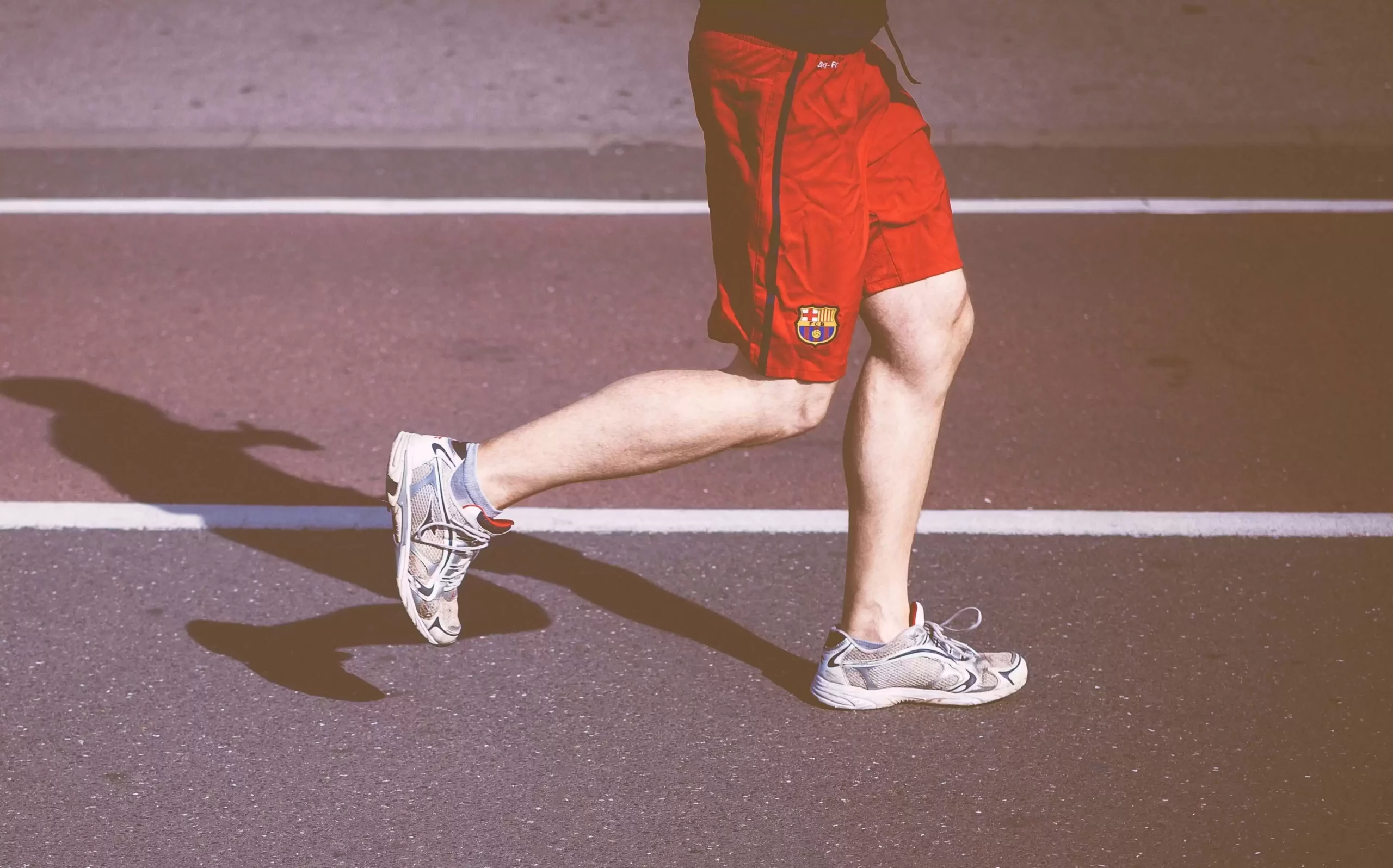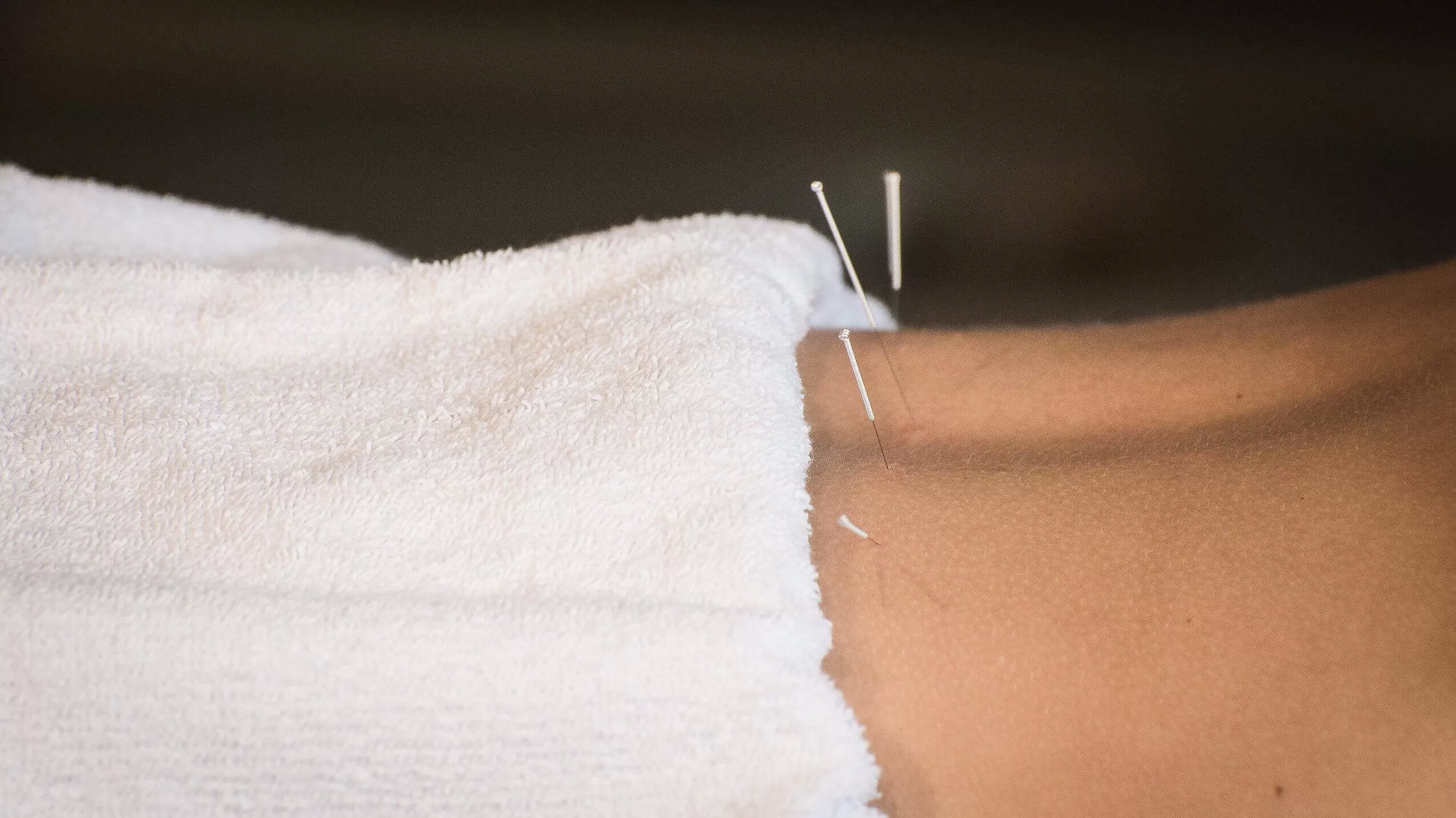Winter is here and the snow is around the corner. The season for skiing is upon us. Whether you are a novice skier or experienced in the sport, there is always a possibility of an injury. This article talks about common skiing injuries and how you can recover from them.

What are some common snow sports injuries?
Some common injuries sustained during skiing are:
Head
- Concussion
- Traumatic brain injury
Neck & Shoulders
- Whiplash
- Fracture
- Torn rotator cuff
- Shoulder dislocation
Back & Spine
- Herniated disks
- Lower back pain
Hand
- Skier’s thumb
- Wrist sprain
- Finger fracture
Knees & Legs
- ACL/PCL rupture
- Meniscus injury
- Fracture
How can I protect my knees while skiing?
Using properly adjusted bindings, maintaining proper ski technique, and conditioning exercises to strengthen the muscles around the knee can help protect against knee injuries.
What is “snowboarder’s fracture”?
Snowboarder’s fracture refers to a fracture of the lateral process of the talus bone in the ankle, usually caused by an inversion injury when landing from a jump.
Are head injuries common in skiing?
Head injuries can occur in skiing, especially in the absence of helmets. Wearing a properly fitted helmet significantly reduces the risk of head injuries.
How do I know if I have a concussion from skiing?
Symptoms of a concussion may include headache, dizziness, nausea, confusion, sensitivity to light, and memory problems. If you suspect a concussion, it’s crucial to seek medical attention.
What do I do after I get injured while skiing?
No matter how minor the injury, it is advisable to seek a doctor or physiotherapist’s advice to make sure it does not get worse. A physiotherapist can assess the extent of your injury. Follow their advice and recommendations for treatment.
When should I seek medical help for a ski injury?
Seek medical help if you experience severe pain, swelling, inability to bear weight, persistent joint instability, or any symptoms of a head injury or concussion. It’s essential not to ignore potentially serious injuries.
How do I book an appointment with a physiotherapist near me?
Click HERE to book an appointment with a physiotherapist or chiropractor at one of our eight locations.
- Physiotherapy Etobicoke – Triangle Physiotherapy Etobicoke
- Oakville Physiotherapy Clinic – Triangle Physiotherapy Oakville
- Physiotherapy North York – Triangle Physiotherapy North York
- Mississauga Physiotherapy Clinics – Triangle Physiotherapy Mississauga
- Downtown Physiotherapy Clinics – Triangle Physiotherapy King West
- Uptown Physiotherapy Clinics – Triangle Physiotherapy Lawrence Park
- Physiotherapy Clinic Downtown Toronto – Triangle Physiotherapy Queens Quay
- Physiotherapy Clinics Mississauga – Triangle Physiotherapy Erin Mills
“Recovering from a skiing injury requires targeted physiotherapy to regain strength and mobility. Triangle Physiotherapy offers specialized services across the GTA, including Physiotherapy in Etobicoke, Oakville, North York, Toronto, Lawrence Park, Queens Quay, Erin Mills, Mississauga, and Liberty Village. Our experienced team is dedicated to guiding you through a safe and effective recovery process.”
✔️ Physiotherapy absolutely works!
Physiotherapy is a legitimate and effective healthcare practice that aims to improve and restore physical function and mobility, reduce pain, and enhance overall well-being. It is commonly used to treat a wide range of conditions, injuries, and illnesses. Physiotherapists, also known as physical therapists, are trained healthcare professionals who use various techniques, exercises, and modalities to help patients recover from injuries, manage chronic conditions, and improve their physical capabilities.
What is Physiotherapy?
- Physiotherapy is used to help people affected by injury, illness, or disability through movement, exercise, manual therapy, education, and advice.
- At Triangle Physiotherapy, we work in partnership with our patients to help them recover and stay well.
- We use advanced techniques along with evidence-based care. The utilization of these skills allows our physiotherapists to assess, diagnose, treat, and prevent a wide range of health conditions and movement disorders.
What are the benefits of physiotherapy treatment?
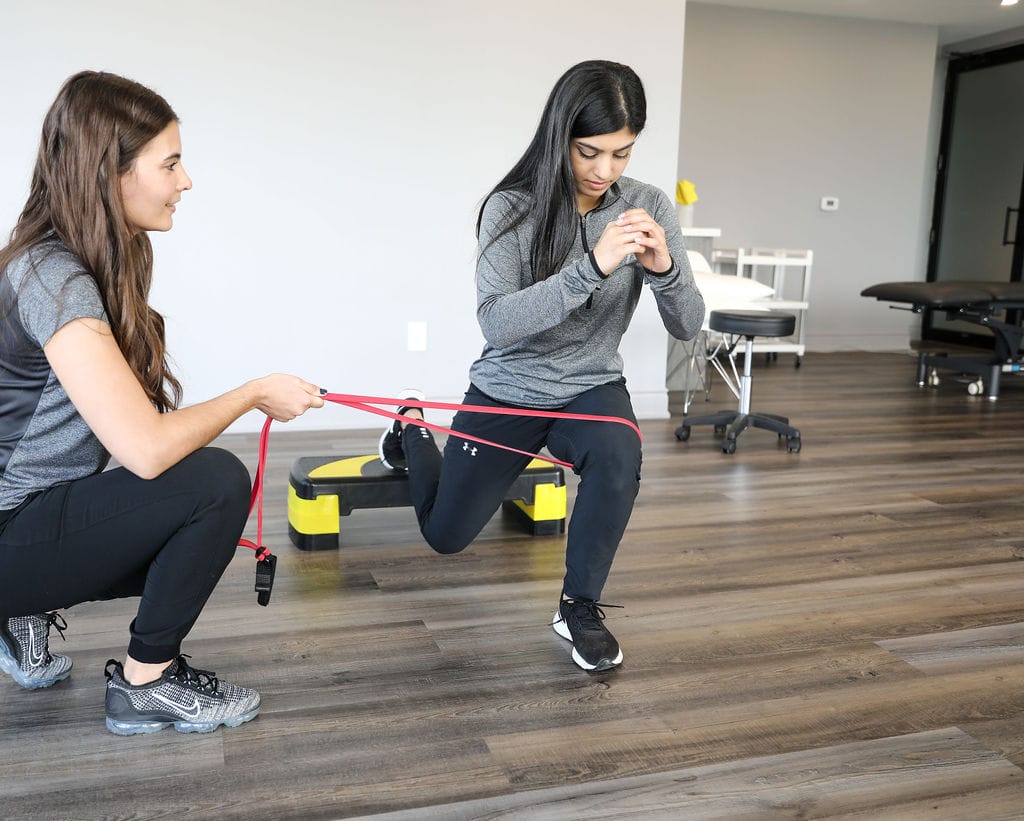
- Injury Rehabilitation: Physiotherapists play a crucial role in rehabilitating injuries, such as sprains, strains, fractures, and surgeries. Physiotherapists develop personalized treatment plans to help patients regain strength, flexibility, and mobility.
- Pain Management: Physiotherapy techniques, including manual therapy, massage, and therapeutic exercises, can help reduce pain and discomfort associated with musculoskeletal issues, neurological conditions, and chronic pain.
- Neurological Conditions: Physiotherapy is used to improve motor function, balance, and coordination in individuals with neurological conditions such as stroke, Parkinson’s disease, multiple sclerosis, and spinal cord injuries.
- Cardiopulmonary Rehabilitation: Physiotherapy is involved in rehabilitating individuals with heart and lung conditions, helping them regain cardiovascular fitness and respiratory function.
- Posture and Ergonomics: Physiotherapists can provide guidance on maintaining proper posture and ergonomics to prevent musculoskeletal problems and discomfort.
- Sports Injuries: Physiotherapy is commonly used in sports medicine to treat and prevent sports-related injuries, enhance athletic performance, and aid in sports-specific training.
- Geriatric Care: Physiotherapy can help older adults maintain their independence, improve mobility, and manage age-related conditions like arthritis and osteoporosis.
- Pediatric Conditions: Physiotherapists work with children to address developmental delays, congenital conditions, and other pediatric issues that affect mobility and physical function.
- Preventive Care: Physiotherapists can provide education and exercises to prevent injuries and improve overall physical health and fitness.
- Pelvic Health: Pelvic Floor Physiotherapy refers to a specific and advanced field within physiotherapy that deals with Pelvic Floor Dysfunction. Pelvic Floor Dysfunction can impact people of any age or gender and the term describes several conditions that may affect the urinary, reproductive, digestive, sexual, and/or stability systems in the pelvis. Pelvic Health Physiotherapists have post-graduate training in pelvic health and can resolve many pelvic floor issues in people of all genders and ages.
- Cancer Rehabilitation: Cancer rehabilitation can help you to lessen and overcome these side effects and help you to participate in all your meaningful daily activities. The goal of cancer rehabilitation is to thus improve your daily function and physical and mental well-being both during and after your cancer treatments. Triangle Physiotherapy has trained physiotherapists that provide cancer rehabilitation services to help manage the common side effects of cancer and cancer treatment.
How do I get the most out of my Physiotherapy Appointment?
Getting the most out of your physiotherapy appointment involves effective communication, preparation, and active participation. Here are some tips to help you make the most of your physiotherapy session:
- Be Prepared:
- Write down your symptoms, concerns, and questions beforehand.
- Note any changes in your condition since your last appointment.
- Bring relevant medical reports, imaging results, or a list of medications you’re taking.
- Arrive Early:
- Arriving a few minutes early will give you time to complete any necessary paperwork and relax before your session.
- Effective Communication:
- Clearly describe your symptoms, their onset, severity, and any factors that worsen or alleviate them.
- Be honest about your lifestyle, activities, and habits that could impact your condition.
- Ask questions if you don’t understand something. Your physiotherapist is there to help you.
- Set Clear Goals:
- Discuss your goals with your physiotherapist. What do you want to achieve through physiotherapy? This could be pain relief, improved mobility, or functional goals.
- Follow Instructions:
- Listen carefully to the advice and instructions provided by your physiotherapist.
- Follow the recommended exercises, stretches, or home-care routines diligently.
- Ask Questions:
- Don’t hesitate to ask questions about your condition, treatment plan, exercises, or any concerns you might have.
- Understand Your Treatment Plan:
- Make sure you understand your treatment plan, including the goals, expected outcomes, and duration of treatment.
- Attend your Appointments Consistently: Your treatment plan may prescribe multiple sessions over weeks or months to achieve your health and recovery goals. Attend the sessions recommended by your physiotherapist in your treatment plan to ensure you can achieve the results you are looking for. Sometimes you may feel you are 100% better once your pain is gone but the underlying issue may not be completely resolved and you may risk a recurrence.
- Take Notes:
- Jot down key points, exercises, or recommendations during the session so you can refer back to them later.
- Feedback:
- Provide feedback to your physiotherapist about your progress and any changes you’ve noticed.
- Be Patient:
- Understand that progress may take time. Don’t get discouraged if you don’t see immediate results.
- Hygiene and Attire:
- Wear comfortable clothing that allows easy access to the area being treated.
- Maintain good hygiene, especially if your session involves physical contact.
- Engage Actively:
- Participate actively during the session. Follow your physiotherapist’s instructions and give your best effort during exercises.
Remember, your physiotherapist is there to help you achieve your goals and improve your health and well-being. By being proactive, engaged, and open in your communication, you can maximize the benefits of your physiotherapy appointments.
Which is the closest Physiotherapy clinic near me in Etobicoke?
Our physiotherapy center in Etobicoke is located at 1 The East Mall Crescent near Cloverdale Mall. The closest intersection is Dundas St. W & The East Mall Crescent.
What makes you different from all the other clinics that also provide physiotherapy services near me?
We have been trusted by the residents of the Greater Toronto Area with their physiotherapy needs for over 15 years and we have now become one of the best Physiotherapy clinics in the GTA with numerous reviews to prove it.
Our physiotherapists at our Etobicoke location are all registered physiotherapists and are dedicated in providing the best Physiotherapy service possible.
Why do I need to be treated by a registered physiotherapist?
It is of utmost importance to ensure that you are being seen by a registered Physiotherapist because behind every registered Physiotherapist yes years of academic and clinical training as well as extensive knowledge of all the systems of the human body. At our physiotherapy center, we guarantee that every single physiotherapist we have is registered and will take excellent care of you.
Is there a highly qualified physiotherapist at your physio clinic in Mississauga who you would recommend I see?
Our physiotherapy center in Mississauga has highly qualified professional physiotherapists with many years of experience. We have physiotherapists with FCAMPT designation, which is the highest certification in manual therapy.
We also have a team of highly skilled professionals including physiotherapists, massage therapists, acupuncturists, chiropractic doctors as well as naturopathic doctors. You are welcome to read their profiles on our website or call us for more information.
How do I book an appointment at a Physiotherapy Clinic near me?
Click HERE to book an appointment with a physiotherapist or chiropractor at one of our eight locations.
- Physiotherapy Etobicoke – Triangle Physiotherapy Etobicoke
- Oakville Physiotherapy Clinic – Triangle Physiotherapy Oakville
- Physiotherapy North York – Triangle Physiotherapy North York
- Mississauga Physiotherapy Clinics – Triangle Physiotherapy Mississauga
- Downtown Physiotherapy Clinics – Triangle Physiotherapy King West
- Uptown Physiotherapy Clinics – Triangle Physiotherapy Lawrence Park
- Physiotherapy Clinic Downtown Toronto – Triangle Physiotherapy Queens Quay
- Physiotherapy Clinics Mississauga – Triangle Physiotherapy Erin Mills
“Physiotherapy is an effective treatment for a wide range of conditions, helping individuals recover and improve their quality of life. Triangle Physiotherapy offers expert services across the GTA, including Physiotherapy in Etobicoke, Oakville, North York, Toronto, Lawrence Park, Queens Quay, Erin Mills, Mississauga, and Liberty Village. Our experienced physiotherapists are committed to helping you achieve your health goals through personalized and evidence-based treatments.”
What is Shockwave Therapy?
Shockwave Therapy is a non-invasive treatment procedure that essentially involves creating a series of short energy acoustic wave pulsations that are directly applied to an injury. It uses a pneumatic generator to physically deliver the shock wave through the skin, into the body. The short-energy acoustic waves that are transmitted through the surface of the skin are spread spherically into the body and the body responds with increased metabolic activity around the pain area. It is a fast and alternative solution to surgery.
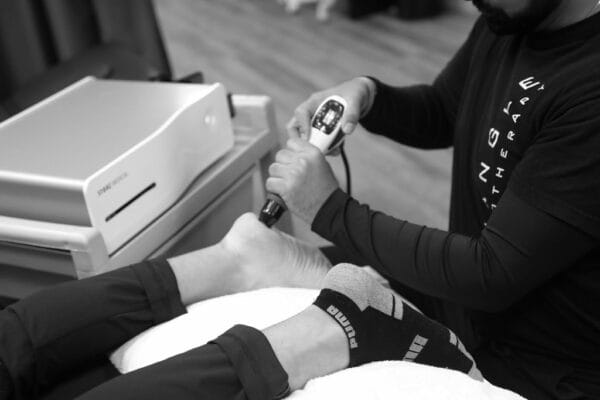
Shockwave Therapy was originally invented for the treatment of kidney stones to blast the rigid tissues into smaller pieces, making it easier to pass. After the effectiveness of that treatment was established, researchers began studying the effects of the machine at different settings and used it to treat calcific tissue and scar tissue in the body. Their findings indicate that this treatment is extremely effective for the treatment of most musculoskeletal conditions in the body.
Benefits of Shockwave Therapy
- Success rate up to 90% in the treatment of soft tissue disorders, including:
- calcific tendinitis of the shoulder,
- plantar fasciitis,
- tennis elbow, and
- piriformis muscle.
- It is an excellent cost-effective treatment
- Helpful in the treatment of chronic pain including:
- shoulder,
- back,
- heel,
- knee, or
- elbow
- No anesthesia or drugs are required
- Varied application in many fields including orthopedics, rehabilitation, and sport medicine
- Latest medical research shows that it can have a positive impact on acute pain
How does shockwave therapy work?
Shockwave Therapy is also known as extracorporeal shock wave therapy [ESWT]. It is a method that is being used more commonly in physiotherapy. Using much lower energy compared to other medical applications, it is primarily used to treat connective tissues such as ligaments and tendons.
Your physiotherapist will evaluate your condition and determine if Shockwave Therapy is appropriate for you. They will also educate you on your condition and recommend additional activities such as activity modification, tennis elbow exercises, acupuncture, massage, and posture correction to help with your healing process.
During the treatment, the therapist will direct the shockwaves into the affected area through the skin, causing no pain. The therapy is typically performed in several sessions and is a safe, non-invasive, and drug-free solution for chronic pain in the shoulder, back, heel, knee, or elbow. The latest medical research also shows that it can have a positive impact on acute pain. Shockwave Therapy is widely used in fields such as orthopedics, rehabilitation, and sports medicine.
Book an appointment for Shockwave Therapy here.
Shockwave therapy is a non-invasive treatment used to accelerate healing and reduce pain in conditions like plantar fasciitis, tendonitis, and other musculoskeletal disorders. It works by delivering high-energy sound waves to the affected area, stimulating blood flow and promoting tissue regeneration. Triangle Physiotherapy offers this treatment across various locations in the GTA, including Physiotherapy in Etobicoke, Oakville, North York, Toronto, Lawrence Park, Queens Quay, Erin Mills, Mississauga, and Liberty Village.
Should I go to a physiotherapist after a car accident?
If you met with a car accident and having problems related to the mobility of your body or if it causes obstacles to function properly and efficiently then you should definitely go for Physical Therapy.
Physical therapists are musculoskeletal experts and may help cure the underlying musculoskeletal injuries that may have occurred after meeting with a car accident. At Triangle Physiotherapy, our Physical Therapists will assure a one-to-one session where they will conduct an extensive whole-body analysis with a target of developing a customized treatment and detailed physical therapy programs which suit best to your condition and individual needs.
What can a physiotherapist do to help after a car accident?
The goal of physical therapy is to help you recover physically and strengthen damaged muscles and tissues.
A Few physical therapy exercise programs would include:
- Manual therapy to mobilize joints, decrease scar tissue, reduce inflammation and enhance healing of tissue.
- Custom exercises to address types of pain like neck and shoulder pain, back pain, spine dysfunction, or weakness.
- Postural training to resolve pain in the neck, shoulders, and back.
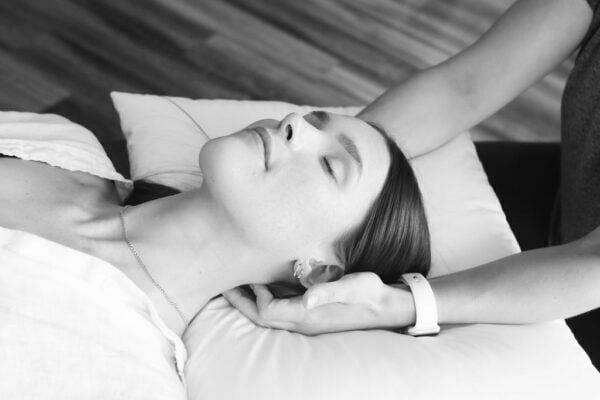
COMMON TYPES OF INJURIES
The list of injuries if you meet with a car accident are as follows:
- Whiplash
- Headaches
- Back Pain
- Neck Pain
- Shoulder Pain
- Knee Pain
What are the common symptoms related to WHIPLASH?
Common symptoms related to whiplash include:
- Stiffness to neck, arms, upper back, and the face.
- Numbness into arms, neck, and upper back.
- Headache, dizziness, nausea.
- Feelings of general weakness.
- Altered and disturbed sleeping habits and patterns.
- Difficulty with concentration.
Is it important to get physiotherapy as soon as possible after a car accident?
Although you may feel the immediate onset of pain or symptoms of injury, these symptoms may bring forth pain and mobility problems over the long haul.
Suppose if you met with a car accident, one may wonder that why is it necessary to get treated with Physiotherapy after an accident? If you’re considering Physiotherapy after a car accident, there are many reasons that you may want to begin or continue with the treatment.
The doctor will recommend that you receive Physiotherapy and you will realize the benefit of rehabilitation after a car accident. You may realize on your own that you can benefit from rehabilitative treatment.
Here’s why you should start Physical Therapy after a car accident:
- Physical Therapy After a Car Accident Can Help You Recover Faster
Going through Physical Therapy after a car accident can help you speed up your recovery time. It can help the body recover its lost strength so that you can reduce the amount of time it takes to improve and fully recover from the injuries caused by car accidents. Time and again patients don’t realize how bad their car accident injuries are until they return to their day-to-day activities.
If you are looking for a physiotherapist to help you with your injuries, our rehabilitation facility is one of the best physiotherapy clinics:
- Physical Therapy Can Help You Recover Better and Prevent Long-term damage
In order to help you recover faster, Physical Therapy programs ensure a better outcome after taking good care and following Physical Therapy exercises. It can also help you or prevent the long-term effects of your injuries like chronic pain and migraines. Unfortunately, car crashes can cause nagging damage if the patient’s injuries are not addressed right away. If you begin physical therapy immediately after your car accident, it’s more expedient to live a pain-free life for years.
- Boosting Mental Health and Improving Quality of Life
Some issues can create a problem after years of being a victim of a car accident and this can seriously affect the quality of life of a person. Physical therapy relieves these issues before becoming a serious health concern for an individual.
- Avoiding Surgery
Every so often injuries caused by car accidents can even require surgery, most injuries or a type of wear and tear but a few injuries, if left rampant, can lead to surgery and costly hospital bills. It is always advised to immediately check-up with a professional for the treatment. This will help with any claims you may wish to make later on. Physical therapy treatment is a much more cost-effective solution to recovery.
There are multiple benefits of physiotherapy and that’s why people are opting for this line of treatment for recovery and overall well-being.
Steps to take after a car accident and a few advantages of Physiotherapy:
- The Type of Injury
Car accident injuries can affect your recovery time and the time period that takes to complete your treatment. One of the most common car accident injuries is whiplash. A whiplash injury occurs when the force of the accident causes your head and neck to jerk violently forward and backward. This can cause the muscles and tendons in your neck to stretch outside their normal range of motion. Whiplash can also affect the spinal column in your neck and disc injuries can be serious. Depends on the intensity of the whiplash, it can take a few months to recover and get the accurate motion of the neck as it was before.
2. The Severity of the Accident
It is more likely to sustain a moderate to severe injury in a more serious car accident, even the smallest of the injury. A more severe accident can cause consequential harm to your body even if you are taking all precautions of car safety like wearing the seatbelt and the airbag deploys. More serious injuries like a dislocated knee or a broken foot can impact your daily routines.
3. Any Previous Injuries
A previous injury can leave behind scar tissue, that impacts how your body heals the new injury. Physiotherapy often takes longer if you have previous injuries, especially if they occur in the same area.
Few factors that effect are:
- The severity of the injury
- Location of the injury
- Patient’s current state of health
- Patient’s treatment goals
- Rate of progress
How can Physiotherapy help if you’ve met with a car accident?
Physiotherapy helps reduce the pain and discomfort usually felt after a car accident injury. A lack of physical activity when recovering from an injury can actually cause stiffness, which can lead to more discomfort when trying to return to your daily activities, so you should always try to keep your body in motion.
“Recovering from a car accident requires targeted physiotherapy to restore mobility and reduce pain. Triangle Physiotherapy offers expert care across the GTA, including Physiotherapy in Etobicoke, Oakville, North York, Toronto, Lawrence Park, Queens Quay, Erin Mills, Mississauga, and Liberty Village. Our experienced team provides personalized rehabilitation plans to help you recover effectively and regain your quality of life.”
Piriformis Syndrome is a neuromuscular disorder that is caused when the piriformis muscle compresses the sciatic nerve. The piriformis muscle is a flat, band-like muscle located in the buttocks near the top of the hip joint. This muscle is important in lower body movement because it stabilizes the hip joint and lifts and rotates the thigh away from the body. This enables us to walk, shift our weight from one foot to another, and maintain balance. It is also used in sports that involve lifting and rotating the thighs, in short, in almost every motion of the hips and legs.
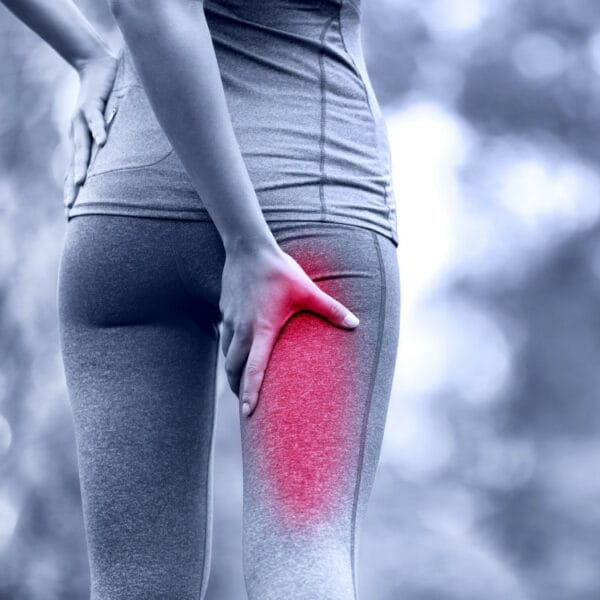
Causes of Piriformis Syndrome
The exact causes of piriformis syndrome are unknown. Suspected causes include:
- Muscle spasm in the piriformis muscle, either because of irritation in the piriformis muscle itself, or irritation of a nearby structure such as the sacroiliac joint or hip
- Tightening of the muscle, in response to injury or spasm
- Swelling of the piriformis muscle, due to injury or spasm
- Bleeding in the area of the piriformis muscle.
Also read, Best Mississauga Physiotherapy Clinic
Symptoms of Piriformis Syndrome
Most commonly, patients describe acute tenderness in the buttock and sciatica-like pain down the back of the thigh, calf and foot. Typical piriformis syndrome symptoms may include:
- A dull ache in the buttock
- Pain down the back of the thigh, calf and foot (sciatica)
- Pain when walking up stairs or inclines
- Increased pain after prolonged sitting
- Reduced range of motion of the hip joint
- Symptoms of piriformis syndrome often become worse after prolonged sitting, walking or running, and may feel better after lying down on the back.
Also Read, Triangle Physiotherapy Clinic at Oakville
Physiotherapy Treatment for Piriformis Syndrome
Ice Packs and Ice Massage
At the onset of pain, lie in a comfortable position on the stomach and place an ice pack on the painful area for approximately 20 minutes. Repeat as needed every 2 to 4 hours.
It may be more helpful to combine a gentle massage with the ice. Lie on the stomach and have someone gently massage the painful area with a large ice cube. If ice is applied directly to the skin (instead of a cold pack), limit it to 8 to 10 minutes to avoid an ice burn.
Heat Therapy
Some people find it helpful to alternate cold with heat. If using a heating pad, lie on the stomach and place the heating pad on the painful area for up to 20 minutes. Be sure to avoid falling asleep on a heating pad, as this may lead to skin burns.
Electrotherapy
The application of electrical stimulation to the buttock with a transcutaneous electrical nerve stimulation (TENS) unit or interferential current stimulator (IFC) can help to block pain and reduce muscle spasm related to piriformis syndrome.
Also Read, Best Physiotherapists in Etobicoke
Piriformis stretches
There are a number of ways to stretch one’s piriformis muscle. Two simple ways include:
- Lie on the floor with the legs flat. Raise the affected leg and place that foot on the floor outside the opposite knee. Pull the knee of the bent leg directly across the midline of the body using the opposite hand or a towel, if needed, until stretch is felt. Do not force knee beyond stretch or to the floor. Hold stretch for 30 seconds, then slowly return to starting position. Aim to complete a set of three stretches.
2. Lie on the floor with the affected leg crossed over the other leg at the knees and both legs bent. Gently pull the lower knee up towards the shoulder on the same side of the body until stretch is felt. Hold stretch for 30 seconds, then slowly return to starting position. Aim to complete a set of three stretches.
Ref: https://en.wikipedia.org/wiki/Piriformis_muscle
http://www.spine-health.com/conditions/sciatica/symptoms-and-diagnosis-piriformis-syndrome.
Piriformis syndrome can cause significant discomfort and requires targeted physiotherapy to alleviate pain, improve mobility, and prevent further issues. If you are looking for professional physiotherapy services to manage piriformis syndrome, there are clinics in physiotherapy Etobicoke, Oakville, North York, Toronto, Lawrence Park, Queens Quay, Erin Mills, Mississauga, and Liberty Village. These clinics offer specialized care and personalized treatment plans to help you recover and regain full mobility.
Exercises are great, and if done regularly they are one of the most important aspects of a healthy lifestyle. They help manage your weight and reduce the risk of chronic diseases development. For certain conditions, specific exercises can be even more beneficial as they can help with condition management and prevention. Spondylolisthesis exercises can help patients suffering from Spondylolisthesis or back pain, thigh pain and stiffness in the back and legs.
What is spondylolisthesis?
Spondylolisthesis is a condition which affects the lower vertebrae, or lumbar spine. It involves one vertebrae slipping forwards or backwards in relation to the vertebra below. It causes pain in the back itself and can also cause nerve impingement of the nerves of the lower back. While it may sound like surgery would be the only option for a condition like this, exercises can play a significant role in managing symptoms and increasing range of motion in this condition.
Also read, Physiotherapy Clinic in Etobicoke
Now that we know more about Spondylolisthesis, let’s look at some of the causes
- Causes can vary with age, health, lifestyle and heredity. While children can suffer from Spondylolisthesis as a result of birth defect, people from all ages are susceptible to the condition.
- Any sport that causes stress on your lower back can result in the development of this condition. Some examples are: gymnastics, weightlifting, football, etc.
- Any trauma or injury, such as in a car accident, can also be the reason for vertebra to slip forward or backward.
Spondylolisthesis exercises
Spondylolisthesis or spondylolysis exercises are recommended by clinicians as they focus on improving range of motion and strength in order to and reduce muscle strain. The following are good beginner exercises to improve overall spine health:
- Pelvic tilt
- Dead Bug
- Partial curl
- Gluteal stretch
- Double-knee to chest
- Bird-dog
- Side Plank
- Twisting the lower back
Also read, Physiotherapy Clinic in Oakville
Avoid high impact exercises and heavy weight lifting. At Triangle Physiotherapy, we will conduct a thorough assessment of your condition and develop a custom treatment plan which will involve exercises that address your individual needs. Book an appointment today with one of our clinicians and feel relief from your back pain once and for all!
Managing spondylolisthesis involves specific exercises and physiotherapy to stabilize the spine, reduce pain, and improve function. For professional physiotherapy services tailored to managing spondylolisthesis, consider visiting clinics in physiotherapy Etobicoke, Oakville, North York, Toronto, Lawrence Park, Queens Quay, Erin Mills, Mississauga, and Liberty Village. These locations provide expert care and customized treatment plans to help you manage your condition effectively and enhance your quality of life.
Isn’t it so unfair?! Last night you were all fine before going to bed but the next morning you woke up with a sore shoulder. The uninvited shoulder pain makes you continuously look back and think of how you might have injured it. Maybe it was an intense dance lesson from last week, a strenuous workout, or even sleeping incorrectly. Not being able to figure it out, you carry on with your day, all the while noticing that something is feeling off.

Also read, Best Physiotherapy Clinic in Etobicoke
Below are a few common reasons that can cause “random” shoulder pain:
- Thoracic Spine Stiffness: The stiffness in the thoracic spine is mainly caused by lack of movement or prolonged sitting, which is more likely to happen since more people are having sedentary jobs. In such cases, we tend to round our shoulders more which eventually puts too much stress on underlying structures.
- Frozen Shoulder: A condition which causes a significant amount of scar tissue to be deposited all around the shoulder capsule, causing a noticeable range of motion restrictions, strength loss, and pain.
- Rotator Cuff Tendonitis: This usually occurs when the rotator cuff tendons in the shoulder are overworked or strained because of an injury. You might even hear a snapping sound when you move your shoulder. Exerting pressure on the shoulder, sleeping incorrectly, and poor shoulder mechanics are some of the causes of this condition.
- Shoulder Impingement: Sleeping on one arm can result in shoulder impingement. Shoulder impingement can also be caused due to excessive shoulder movements, ligament laxity, muscular weakness around the joint, poor posture, previous injury, etc.
- Scapular Dyskinesis: Also known as Chicken wing shoulder blades, this condition causes you to have poor muscular control of your shoulder blades. There can be muscle pain or joint pain around the scapula when carrying heavy objects.
- Referred Pain: Many people come to our physiotherapy clinics complaining about their shoulder pain, but after a thorough examination we realize that the pain is referred from their neck. It is important to see a Physiotherapist that understands this link and treats the right thing!
Also read, Physiotherapy Rehab Clinic in Oakville
How can I get relief from shoulder pain?
A few simple solutions which will give you some relief are:
- Avoid intense activities
- Maintain a proper posture
- Don’t sleep with your elbow over your head; this can compress the tendons of the shoulder and increase your pain
At Triangle Physiotherapy, will assess your shoulder and create a comprehensive treatment plan for you. Our treatment will involve a combination of hands-on manual therapy techniques as well as a custom exercise plan to help you on your road to recovery. Book your appointment now and stop letting your shoulder prevent you from doing the things you want to do!
Waking up with a sore shoulder can significantly affect your daily life, and physiotherapy can provide effective solutions to alleviate pain and improve mobility. If you’re looking for professional physiotherapy care, there are excellent clinics in physiotherapy Etobicoke, Oakville, North York, Toronto, Lawrence Park, Queens Quay, Erin Mills, Mississauga, and Liberty Village. These clinics offer specialized treatment plans to help you manage shoulder pain and enhance your overall well-being.
Our feet are likely the most used body parts of all of our limbs. Be it sitting or standing, we are always using our legs in one way or the other. In fact, the use of our feet and legs usually begins the moment we wake up. So it is safe to say that our feet play a vital role in our day-to-day life and as such, it is important to take good care of them. Our feet carry the entire weight of our body throughout the day. They undergo tremendous pressure with every step we take as they get compressed and endure repeated movement against our footwear. Over a period of time, pressure on certain parts of the foot can increase and the body compensates by adding extra layers of scar tissue and skin on parts of feet that undergo high pressure, such as the ball and heel & toes of the foot. This can cause there to be painful areas of pressure on the foot or the formation of callouses on areas of higher pressure on the foot.
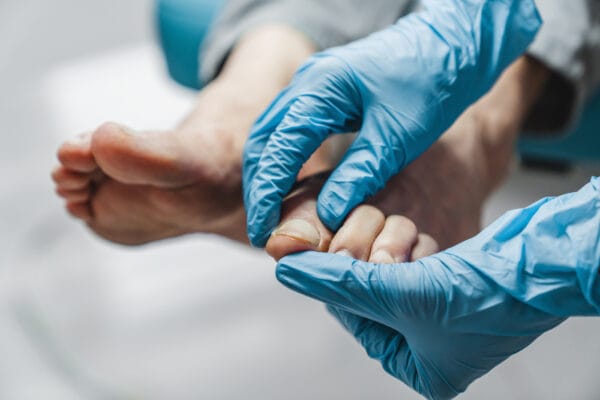
Also read, Best Physiotherapy Clinic in Etobicoke
Why schedule an appointment with a Chiropodist?
Walking, running, sitting – everything involves your legs. A minor injury or pain can cause huge discomfort in your everyday life and can escalate to become a serious issue. For example, an ingrown toenail or an infection can be very painful and uncomfortable. Seeing a Chiropodist at an earlier stage will help immensely in preventing and managing these kinds of foot-related problems.
An appointment with a Chiropodist will involve a thorough assessment of your foot-related problem and treatment that will help alleviate the problem. Even without a significant ongoing foot issue, a visit to the Chiropodist can help you in preventing one from developing by gaining more insight into your walking pattern or providing education on correct foot care. They are trained to diagnose and treat a wide variety of foot-related conditions and are able to understand their patient’s needs in order to prevent and treat both acute and chronic conditions that involve the foot and lower limb functions.
Also read, Best Physiotherapy Clinic in Oakville
What do we treat at Triangle Physiotherapy?
Our Chiropodist is a highly skilled professional that is an expert in their field. At Triangle Physiotherapy, our registered Chiropodists diagnose, assess, and treat a wide range of foot-related health issues and abnormalities including but not limited to:
- Alignment and support to prevent or correct abnormalities in the lower limbs
- Abnormal gait patterns
- Foot pain
- Sports injuries
- Diabetic foot care
Also read, Best Physiotherapy Treatment in Mississauga
How to Contact Triangle Physiotherapy?
We have 8 clinics located across the GTA: Etobicoke, Oakville, Mississauga, North York, and Toronto (King Street West, Queens Quay, and Yonge Street. If you have any questions regarding what type of chiropody treatment may be appropriate for you, please call or email us and we will be happy to answer your questions. You can also Book an Appointment with a Chiropodist now.
Chiropodists play a vital role in managing foot and lower limb conditions, often collaborating with physiotherapists to provide comprehensive care. If you’re looking for professional physiotherapy services to complement chiropody care, consider clinics in physiotherapy Etobicoke, Oakville, North York, Toronto, Lawrence Park, Queens Quay, Erin Mills, Mississauga, and Liberty Village. These locations offer expert care and personalized treatment plans to help you achieve optimal foot health.
Acupuncture is a healing technique used in TCM where practitioners stimulate specific points on the body, most often by inserting thin, sterile needles into the skin.
Acupuncture mainly focuses on correcting imbalances of energy in the body & improves the body’s function by promoting the natural, self-healing process. It is now widely practiced as a therapeutic intervention in North America, in addition to Asia.
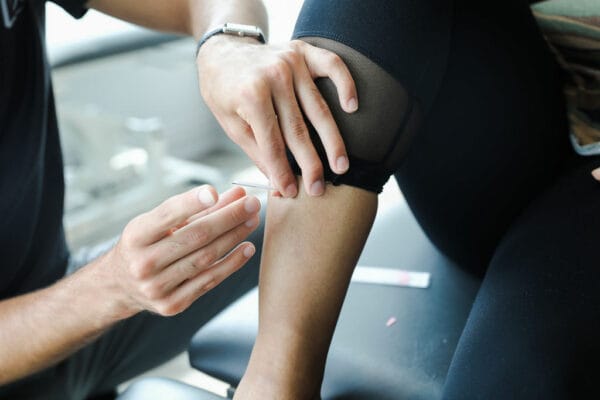
What can acupuncture help with?
The most common method used to stimulate acupuncture points or acupoints is the insertion of fine, sterile needles into the skin. This technique can release blocked Qi in the body and stimulates the body’s natural healing response through various physiological systems. Studies suggest that acupuncture can ease various types of pain generated by conditions such as:
- Low-back pain
- Neck pain
- Knee pain
- Osteoarthritis
- Headaches
- Migraine
- Depression
- Rheumatoid arthritis
- Smoking addiction
- Chronic asthma
- Epilepsy
- Insomnia
Also Read, Physiotherapy Etobicoke
How many treatments will I need?
The frequency of treatments differs from person to person based on their health condition. Some people experience relief in the first treatment itself, whereas others with complex or long-standing chronic conditions may notice more of a significant benefit after multiple treatment sessions. Generally, fewer treatments are required for acute conditions and more treatments are required for chronic conditions. An individualized treatment plan that includes the expected number of treatments will be discussed during the first visit.
In recent years, acupuncture has gained much more traction in Western Medicine. The majority of research on the use of acupuncture in Western Medicine has focused on its use for pain management and inflammation reduction. Thus far, the majority of this research has yielded positive results, indicating that acupuncture is indeed a useful technique for pain management and inflammation reduction.
Our More Locations
Physiotherapy Etobicoke | Physiotherapy Oakville | Physiotherapy North York | Physiotherapy Toronto | Physiotherapy Lawrence Park | Physiotherapy Mississauga | Physiotherapy Queens Quay | Physiotherapy Mississauga Erin Mills | Physiotherapy Liberty Village
At Triangle Physiotherapy, our practitioners and therapists will thoroughly assess your past medical history and will answer any questions that you might have about your condition. This New Year, make sure that you focus on your health to ensure that you have a productive and healthy year!
Acupuncture can be an effective treatment for pain relief, stress management, and promoting overall wellness. If you are looking for physiotherapy services to complement acupuncture, there are clinics in physiotherapy Etobicoke, Oakville, North York, Toronto, Lawrence Park, Queens Quay, Erin Mills, Mississauga, and Liberty Village. These clinics offer comprehensive care with personalized treatment plans to help you achieve optimal health and recovery.
What do we mean by Sports Injuries? Any sort of injury that is caused when we get too involved and carried away in the spirit of any sport. When the passion is high, and the energy is there we tend to suffer from small accidents related to Knee pain, Elbow, etc.
What qualifies as a Sports Injury?
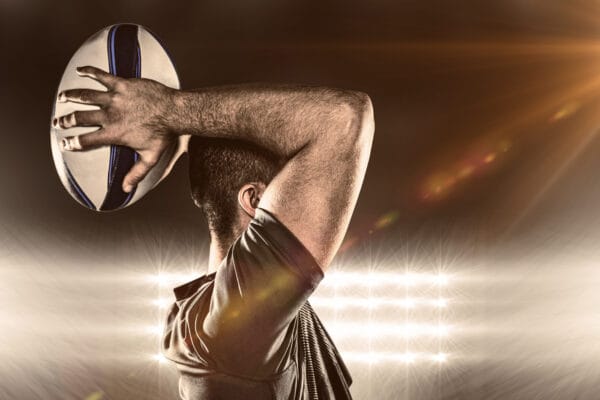
It’s any type of injury that might arise from getting too involved and carried away in the spirit of any sport. In the heat of the moment during a sports game, it is easy to ignore smaller annoyances that might progress to become significant sources of pain.
Also read, Physiotherapy Oakville
So, what do many people do when they inevitably suffer a sports injury?
The most common answer is to go and visit a doctor. However, we tend to forget that the most effective and immediate assistance we can get is from a physiotherapist. Reducing swelling and providing pain relief are usually the first steps that a physiotherapist will take to promote recovery after an injury.
Advanced progression of the treatment plan usually involves techniques like stretching and providing range of motion and strengthening exercises that are meant to help the injured person regain strength and balance. The physiotherapist will also ensure that you don’t push yourself too far or too fast, thereby helping you prevent re-injury.
Below are some common questions and answers that might be relevant to you:
Who is better equipped to diagnose my injury – a doctor or a physiotherapist?
Both doctors and physiotherapists have the necessary skills to diagnose your injury. Interestingly the most important thing is that there is a DIAGNOSIS made!
Who is better equipped to manage/treat my injury – a doctor or a physiotherapist?
Well, it depends on the injury. For example, it is not uncommon for a physiotherapist to refer a patient to a doctor to ask for a prescription for some anti-inflammatory medication as these are not able to be prescribed by a physiotherapist. However, a physiotherapist will generally provide more detail regarding the injury, as well as provide manual treatment and prescribe a detailed exercise program for the patient that will help promote recovery.
Also read, Physiotherapy Clinic Mississauga
When do I need to consult a physiotherapist?
There are many other conditions apart from sports injuries that would require treatment from a physiotherapist. Some of them are:
- Any arthritic conditions
- Treatment of pelvic floor disorders
- Chronic/Overuse injuries
- Muscle or joint issues that might arise during pregnancy
- Vestibular conditions
- Various other muscle strains and sprains
Any of the above-mentioned problems should be treated immediately in order to prevent further aggravation of the condition! Seek the help of our specialists at any of our locations in Etobicoke, Oakville, North York, Mississauga & Toronto, and get rid of such dilemmas!


